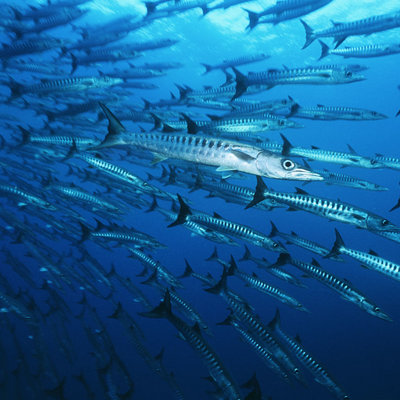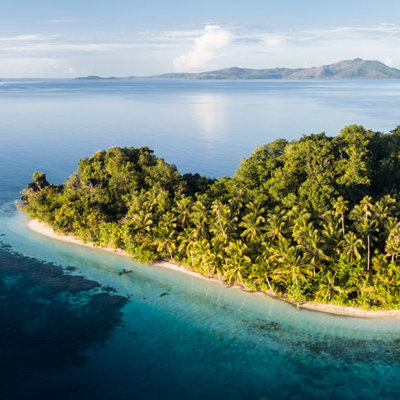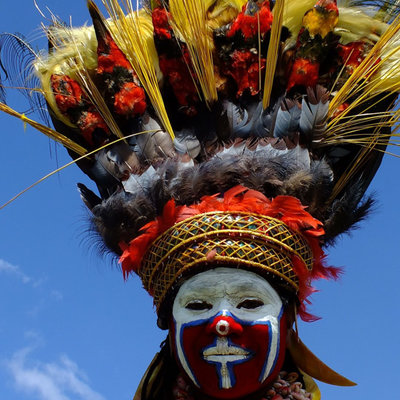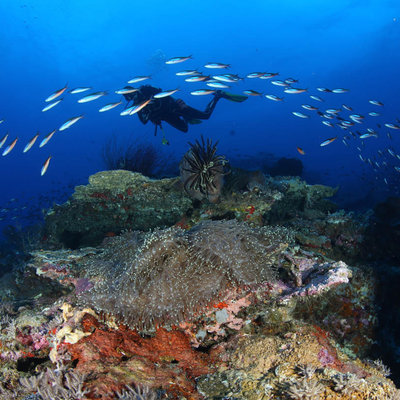PAPUA NEW GUINEA
PAPUA NEW GUINEA is a country in the southwestern Pacific Ocean, encompassing the eastern half of New Guinea, the world’s second-largest island (the western half is made up of the Indonesian provinces of Papua & West Papua) and its offshore islands. The islands are made up of active volcanoes, granite-based and with dense forests. Due to this terrain, there are many traditional tribal villages, many with their own languages. A country of immense cultural & biological diversity, famous for its soft coral & wreck diving, white sand beaches and pristine natural environment, it's also a haven for conservation, with the Coral Sea Foundation & The Conflict Islands Conservation Initiative, leading the way.
HISTORY & CULTURE
People’s daily lives vary enormously in Papua New Guinea, with the great majority of the population living across the diverse rural landscape in villages or hamlets. Daily life usually centres on the extended family, whose primary responsibilities are producing food for subsistence and rearing children. Most people have rights to use portions of land for the growing of food and some cash crops as well as the rights to fish, hunt, and gather timber from local forests. Many of those activities are accompanied by rituals to ensure success and prosperity. Other major rituals, such as menarche ceremonies for girls and initiations for boys, are declining.
The islands that constitute Papua New Guinea were settled over a period of 40,000 years by the mixture of peoples who are generally referred to as Melanesians. Almost all the Melanesian societies are patrilineal, tracing descent through the male line, and even matrilineal societies, where descent is traced through the female line, remain patriarchal—i.e., male-dominated. This “Clan” forms the major unit of social organisation. In some areas, descent and land rights can be claimed through either parent, so people can belong to both their parents’ clans. Marriage within a clan would be perceived as incest, and so marriage is only possible across clan lines and sometimes across the boundaries of a tribe. Large tribes are not the norm, but where they do exist, they have a degree of political unity and can be viewed as federations of clans. They may share origin myths, and in such cases, clans can be seen, as being like “brothers,” sons of a founding father. These social structures form the lines of conflict expressed in the interclan warfare that persists in the Highland provinces, and in those areas, they often form the lines of political competition in contemporary elections.
The clan also has social bonds and obligations under what’s known as the wantok system. It provides support for those struggling but also creates heavy demands on the more affluent people who feel obliged to support their kin. The demands of wantoks are often held to be a root cause of corruption. Some locals feel that this system is being abused as it works well on the islands but if you are in the city working you under obligation to support others who do not have a job. Traditionally there should be a return to the provider at some point.
An abundance of minerals and petroleum brightens the outlook for this tropical nation (however there are environmental issues associated with the extraction of such wealth), comprising eastern New Guinea and many small islands—including Bougainville and the Bismarck Archipelago.
The official languages of the country all reflect its colonial history. English is the main language of government and commerce. In most everyday contexts the most widely spoken language is Tok Pisin (“Pidgin Language”; also called Melanesian Pidgin or Neo-Melanesian), a creole combining grammatical elements of indigenous languages, some German, and, increasingly, English. In addition to the official languages, there are more than 800 distinct indigenous languages.
Since the country achieved independence in 1975, one of its principal challenges has been the difficulty of governing many hundreds of diverse, once-isolated local societies as a viable single nation.
TYPES OF DIVING
Papua New Guinea is relatively hard to access in the sense that it has one international airport, no railroad and not many roads, so domestic flights are the norm, as is boat travel. This means that Liveaboards will tend to leave from a resort which you have to fly into. The bonus is that the resorts are Dive Resorts – so they cater for the diver. Each tends to have its own local reefs with vibrate corals, macro life, with a wreck close by.
WHAT TO SEE DIVING
PNG was home to several Japanese bases and later for the allied soldiers. What this means is that there are shipwrecks and plane wrecks scattered all over the islands and reefs. Match this with unexplored dive sites, with beautiful soft corals, low human activity & interaction, and each dive is a discovery.
DIVE SITES
NEW GUINEA - MILNE BAY
There are two Milne Bays, with the large bay on the south-eastern tip of Papua New Guinea, centred around the provincial capital of Alotau, and the actual Milne Bay province itself. The province stretches out over a huge area covering 270,000 km² – roughly the size of the UK, but only about 14,000 km² of that area is actual land. The rest is taken up by the waters surrounding the 600 islands of the province that fall into four main groups: The Trobriands, the D’Entrecasteaux Islands, Woodlark Island or Muyua Island, and the Louisiade Archipelago (with the Conflict Islands inside).
With such a large area it offers amazing diving, with an array of marine species, wrecks and colourful reefs - covered in elephant sponges & fans; hard corals and deep-water areas with large pelagics cruising past. The outer areas of the Louisiade Archipelago are remote with pristine marine environments, unexplored diving and offer very “Off the beat path” diving. One such area is the Conflict Islands. Located on the main island Panasesa is the Conflict Islands Resort. (For great packages see here).
There are several dive resorts centred around Alotau and several liveaboards departing from the same town, you have a range, from Little critters on the black sand at a site called Dinah’s Beach on the North Coast, down to the South to see Manta Rays on a cleaning station at Samarai Island.
NEW GUINEA - PORT MORESBY
The best dive sites are concentrated along the offshore & sunken barrier reefs. Suzies Bommie teems with marine life. The shipwreck Pacific Gas is one of the best wreck sites in PNG.
NEW GUINEA - TUFI AREA (TUFI RESORT)
Located in the spectacular tropical fjords of Cape Nelson on the north-east coast of the main island of New Guinea. Tufi one of the most picturesque & physically isolated places in all of PNG. It's only accessible by plane or by ferry from Port Moresby, as there are no roads due to the mountain range.
The diving here has inner reefs, outer reefs and a famous wreck as well. The offshore reefs are 5 to 15 nautical miles out from Cape Nelson and rarely dived due to the isolation. They rise from the seabed some 200m below and offer walls, swim-throughs, hard & soft corals, masses of schooling fish and the occasional great hammerhead shark.
The inner reefs are dived regularly by the resort, so no crowds. The Tufi resort jetty has awesome muck/ macro diving with great critters to be found. The best time to dive the outer remote reefs is in October and November, where it’s the transition period of the trade winds, which offers clam seas & great visibility. Also from the Tufi Resort, you can dive the B17 Black Jack aircraft wreck. An amazing dive still in great condition.
NEW BRITAIN - KIMBE BAY
Kimbe Bay is located on the north coast of New Britain, the largest island of the Bismarck Archipelago, with an incredible bio-diversity due to its location, topography & geography. These three factors have created a very diverse marine environment with over 860 species of fish, 400 species of stony corals and 10 spices of whale & dolphin identified. These factors also provide dramatic scenery above water with an array of volcanoes and caldera.
There are many great sites in Kimbe Bay itself, with sites to the northwest in the remote Witu group of volcanic islands. A unique site is Garove Harbour which is located inside the crater of an extinct and submerged volcano. To the northeast, there are the superb Fathers offshore reefs which are the sunken remains of a huge extinct volcanic caldera. Also, a unique WWII aircraft wreck site with the beautifully preserved Mitsubishi Zero Wreck sits in the bay.
NEW BRITAIN - RABAUL
Rabaul is located on the rim of a huge caldera that forms the superb natural anchorage of Simpson Harbor. It was that harbour combined with the town’s strategic location that made it the main army & navy base for the Imperial forces in PNG. When the tide of war turned the Allied Forces counterattacked and Simpson Harbor became the last resting place of an estimated 54 Japanese ships. Not all are accessible with the top three being the Italy Maru – a 5859-ton transporter sitting on its side at 54m, Yamato Maru – a 4359-ton cargo ship with truck bodies still visible, Georges Wreck – a minelayer with the bow in 12m, the stern sitting in 60m, covered in black corals and sea fans in the deeper parts.
In addition to great wreck dives, Rabaul has beautiful, pristine coral dive sites which include Tom, Dick & Harry, Hannah’s Hotspot for schooling & pelagic fish; The Lighthouse, East Point and Pigmie Point for macro enthusiasts; and Reimers Wall and Submarine Base for wall divers.
NEW BRITAIN - THE SOUTH COAST
The south coast of the eastern half of New Britain is a remote area not frequented by many liveaboards. Underwater the area has a mixture of remote and untouched reefs, some excellent critter sites and a few WWII wrecks.
NEW IRELAND & NEW HANOVER
New Ireland Province lays at the far eastern end of the Bismarck Archipelago & consists of many islands, the main island of New Ireland with the second largest New Hanover. The area is known for its WWII wrecks, large pelagics and the big currents that sweep through its northern islands.
The diving is concentrated around Kavieng on the Pacific Ocean side of north New Ireland and is mainly wreck diving, however, there are drift dives along reef walls covered in fans, sponges and brightly coloured hard corals. The walls drop away to great depths and provide the perfect hiding place for small critters like the Pygmy Seahorse and nudibranchs. Several WWII wrecks lay scattered in and around Kavieng Harbour. These include a Japanese merchant ship and many floatplanes. While over on the Bismarck Seaside it is mainly reef diving. New Hanover offers more Japanese WWII wrecks plus some amazing reefs. One such wreck with a well-documented history is The Stubborn Hellion.
NEW GUINEA - MADANG
Madang Province is located on the north coast of New Guinea. Waters surge through the many passages & channels in the reef around Madang, which brings a vast variety of marine species. With coral walls with drop-offs, soft corals, large gorgonian fans, wrecks and large pelagics passing by, each dive will be an experience.
DIVE CONDITIONS
PNG Waters are amazing with many international award-winning photos being taken due to the visibility and overall conditions. In general, its possible to dive all year round with visibility in the region ranges from 20 - 40 metres depending on the season but can get up to 100 meters in places. The monsoon is between December & March which can affect coastal areas with run off. September to November & May to June normally has calm seas, & the best visibility as this is the transition period from one trade wind to another. In July and August, the south-east trade winds can make seas a little choppy and visibility can also drop. In saying that Liveaboards change their itineraries to match this. They look for the best conditions which means avoiding unnecessary winds. (Weather section covers this better).
WEATHER
The south easterlies blow for approximately seven months (May to November) on the extreme southeast of the country (Milne Bay) and for gradually shorter periods in northern areas, predominating for only three months in the Admiralty Islands. Conversely, north westerlies are more common on the north coast and in the Bismarck Archipelago, but they affect Port Moresby for only three to four months of the year (the rainy season, December through March). So, when it’s the wet season in the north it’s dry in the south.
WATER TEMPERATURE
The average water temperature varies very little from 28-30C (82-862F) in the Bismarck Sea. With general 23-31°C (74 -87°F) temperatures in other regions.
AIR TEMPERATURE
The climatic regions of Papua New Guinea are basically tropical, but they are very varied. In the lowlands, mean annual maximum temperatures range from 30 - 32 °C (86 - 90 °F), and the minimums are between 23 - 24 °C (73 - 75 °F). Seasonal variation in temperature is slight. Cooler conditions prevail in the Highlands, where night frosts are common above 2100m (7,000 ft); daytime temperatures in these regions generally exceed 22 °C (72 °F) regardless of season.
RAIN FALL
The monsoon is between December and March.
Rainfall, rather than temperature, is the determinant of season. Precipitation is dependent on two wind systems—the southeast trade winds and the north-westerly turbulence zone (the monsoon)—and on the three site characteristics of latitude, elevation, and exposure.
The south easterlies blow for approximately seven months (May to November) on the extreme southeast of the country (Milne Bay) and for gradually shorter periods in northern areas, predominating for only three months in the Admiralty Islands.
Conversely, north westerlies are more common on the north coast and in the Bismarck Archipelago, but they affect Port Moresby for only three to four months of the year (the rainy season, December through March).
The Highlands seem to have their own airflow systems, receiving rain throughout the year—totalling between 100 and 160 inches (2,500 and 4,000 mm)—except for a midyear dry phase. With the north westerlies, rain is frequently from heated saturated air that loses its moisture as it cools and rises (convectional storms), and rain shadow effects are reduced. With the south easterlies, however, exposure is particularly important.
The Port Moresby coastal area is parched throughout the period of the south easterlies, which flow parallel to the coast, yet where mountainous land lies athwart the airflow, as in New Britain or the southward-facing slopes of the Highlands, rainfall is extremely heavy, frequently exceeding 300 inches (7,600 mm). Port Moresby receives less than 50 inches (1,300 mm) of precipitation annually.
HOW TO GET THERE
Overseas air access is via the INTERNATIONAL AIRPORT AT PORT MORESBY - JACKSONS INTERNATIONAL AIRPORT, IATA CODE POM.
Air Niugini, PNG’s national airline flies to Australia (Cairns, Brisbane and Sydney), Bali (Indonesia), Japan (Tokyo), Philippines (Manila), Singapore, Fiji (Nadi), China (Hong Kong) and Solomon Islands (Honiara). Qantas has a code hare with Air Niugini, and Virgin Australia departs from Australia only. Philippine Airlines & the Solomon Airlines offer flights as well.
PNG Air is the main domestic operator.
Travel light: baggage allowance on internal flights is 10-16kg (check on your domestic flight booking for exact weight allowance).
Internal or domestic flights are more common than road due to the infrastructure. The terrain and the weather make roads hard to create & maintain. There is no railroad.
Domestic Airports
Rabual - Tokua Airport IATA Code - RAB
Tufi - Tufi Airport IATA Code - TFI
Alotau - Gurney Airport IATA Code - GUR
Madang - Madang Airport IATA Code - MAG
Kimbe - Kimbe Airport IATA Code - HKN
Kavieng - Kavieng Airport IATA Code - KVG
VISA CONDITIONS
Individuals are required to apply for the Visitor Visa if they intend to visit Papua New Guinea for reasons such as holidays, sightseeing, social or recreational reasons, to visit relatives and friends. To be eligible for a Visitor visa, you must show that you are a genuine tourist or visitor and intend to leave Papua New Guinea at the end of your stay.
Visitor visas are issued subject to the individual circumstances of the traveler. In most circumstances, you can expect to be issued a Visitor Visa, which is valid for a single entry stay of sixty (60) days from the date of arrival.
There is currently no fee for the Visitor Visa. However, if your circumstances change at any time during the visa application process or after your visa is issued, you must inform ICA. A change in circumstances may affect your ongoing eligibility for the visa issued and affect the fees involved.
How to apply
Travelers who hold a passport from a country that is eligible for the issuance of a visa on arrival may lodge an application via the electronic visa portal. The list of nationalities who are eligible for a visa on arrival is listed here. Countries not currently are Japan, Indonesia & South Korea. - THIS SERVICE IS SUSPENDED
ALL TRAVELERS MUST APPLY ELECTRONICALLY
LOCAL KNOWLEDGE
Cash is King – Plan to pay your way as ATMS’s are only found in the bigger towns. Cards are accepted by top hotels, but otherwise, cash is the main form of payment.
DO NOT take a taxi from the airport, if staying at a hotel they offer free transfers which can be arranged before arrival.
English is widely spoken but Tok Pisin (English-based pidgin) is PNG’s most commonly used language.
The Cuisine may not be very varied as many locals subsist on staples such as yam, sweet potato, taro, and rice. Fresh fish & excellent seafood are found along the coast but tinpis (tinned fish), spam, bully beef & 2-minute noodles is typical expedition fare. In Moresby, you can expect more variety and some high-quality meals at a few of the more gourmet restaurants.
Take a mosquito net & powerful insect repellent with you.
Cellular/ Mobile coverage - Electronic media expanded dramatically in the early 21st century, with a network of cellular telephone transmitters covering all heavily populated areas and even remote regions. Cellular phone usage far surpasses the use of landlines.
Wi-fi is available in most international hotels at a cost, but rare in remote areas. Computer usage is low partly because of the lack of infrastructure. Only a small proportion of the population has access to the Internet, it is used extensively by those who do, notably political bloggers.
Safety - It is NOT recommended to walk around Port Moresby at night.
GENERAL INFOMATION
You can buy most supplies in Moresby, but it’s worth bringing a good mosquito net, torch, waterproof bag, sturdy footwear, and powerful insect repellent from home.
WHAT KIND OF ELECTRICAL PLUGS ARE USED IN PAPUA NEW GUINEA?
You may need an adapter in order to plug your appliances into the power sockets: the adapter required for PNG is the Australian Type 1 plug. The plugs have two flat metal pins, forming an inverted ‘V’ shape, and occasionally a third pin in the centre. The electrical current is 220 – 240 volts, AC 50Hz. (This may vary onboard liveaboards).
Time Zones
There are two time zones: Papua New Guinea Time (PGT) – which is standard time – GMT +10 (same time as Sydney) and the Bougainville Standard Time (BST), which is used in the outer islands – GMT +11.
DO I NEED ANY VACCINATIONS OR MEDICATIONS TO TRAVEL TO PAPUA NEW GUINEA?
Certification or vaccination against yellow fever or cholera is required for travellers over one year of age, coming from or through infected areas. Malaria is a serious health risk in Papua New Guinea. Visitors are strongly advised to consult their local doctor or tropical disease clinic to commence anti-malarial preparations before arrival in PNG. Use insect repellents during your stay, especially around dusk. The World Health Organization (WHO) has reported Vaccine-Derived Polio Virus (Type 1) cases in parts of PNG. Ensure you’re vaccinated against polio. Water quality is within WHO standards in most towns; however, bottled water is available and in rural areas always boil the water.
HOW CAN I CONTACT EMERGENCY SERVICES IN PAPUA NEW GUINEA?
Medivac Pacific Services provides emergency medical services:
Port Moresby Ph: +675 323 5626.
For 24-hour emergency Ph: +675 7683 5227 or +675 7683 1818.
Port Moresby only: Police 112, fire 110/002, St John Ambulance 111.
Papua New Guinea has its own hyperbaric recompression chamber. Located at Port Moresby Medical Services, the DAN-sponsored facility is owned by the Hyperbaric Partners Limited and is supported by the PNG Divers Association through a small chamber levy.
YOU MUST TRAVEL WITH DIVE INSURANCE – for Evacuation/repatriation & Emergency Medical Expenses as there is only one chamber in PNG, the next closest would then be Australia.
IS IT SAFE TO SWIM AT PAPUA NEW GUINEA’S BEACHES?
Most land, beaches, lagoons, bays and islands in Papua New Guinea, are owned by a village, family or individual. You should ask permission for access and a small entry fee may be payable. Be mindful that Papua New Guineans are modest people and not used to seeing women swimming in bikinis. When swimming at our beaches be aware of currents and never swim alone, at night, under the influence of alcohol or directly after a meal. Always check water depth before diving in and never run and dive into the water from the beach.
Crocodiles live in rivers and coastal estuaries in Papua New Guinea, often changing habitat via sea. When travelling near crocodile habitats, don’t swim in rivers, estuaries, deep pools or mangrove shores. Also seek expert local advice about crocodiles before camping, fishing, diving or boating.
Transport around - Internal transport in Papua New Guinea is expensive, whether to the island provinces or by road on the geologically unstable mainland. There are no railroads and few paved roads. Port Moresby is connected by road to only two other provinces and not to any other major population centres. The port city of Lae is linked to Madang on the north coast, and the Okuk (Highlands) Highway connects Lae to the major Highland towns and the Tari gas fields, but it is occasionally blocked for days because of landslides and inadequate maintenance. The rural road network, already in poor repair, is often damaged by heavy rainfall. For places not served by the Highlands road network, air transport is required to travel between the small towns of each province and between Port Moresby and other population centres.







